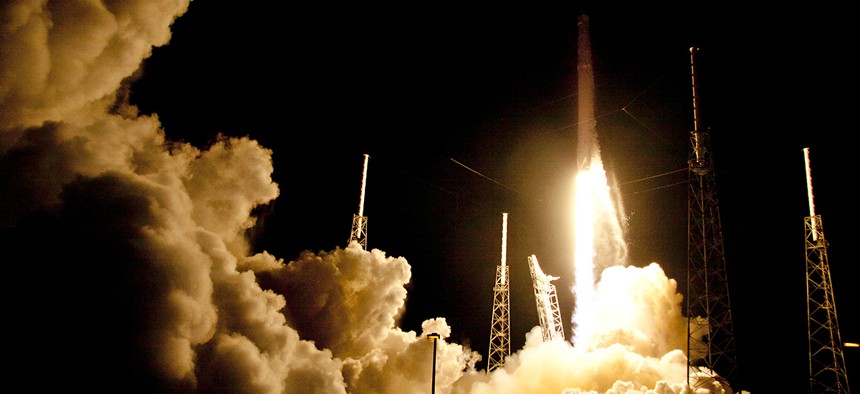SpaceX Breaks 2 Records in Latest Mission to International Space Station

The Falcon 9 SpaceX rocket lifts off from launch complex 40 at the Cape Canaveral Air Force Station in Cape Canaveral, Fla. John Raoux/AP
This was the company's ninth mission to the ISS.
With its ninth mission to the International Space Station today, SpaceX has reached two significant milestones. It returned an orbital rocket booster to a Cape Canaveral, Florida, landing pad for the second time. And it eclipsed its own record for most rockets launched in a year, making seven successful missions in 2016 so far.
You can watch a recording of the launch here, starting 30 seconds before liftoff.
Together, the two achievements capture how CEO Elon Musk’s rocket company aims to combine innovation and reliability—to develop the first reusable orbital rockets even as it dominates the space access business by providing the cheapest, most frequent launches.
tfw you land a real sick burn pic.twitter.com/uYod64nAH4
— Elizabeth Lopatto (@mslopatto) July 18, 2016
Today’s mission—which lifted off at 12:45 am EST—was primarily to convey a Dragon spacecraft loaded with 2.5 tons of cargo to the International Space Station. Besides food, water and oxygen, the gear includes include numerous science experiments that will allow NASA researchers to test new space technology and study the human body.
Dragon is also ferrying up an adapter that will be installed on the ISS so future manned spacecraft can dock more easily at the station. SpaceX first attempted to bring up the adapter last year, but its Falcon 9 rocket exploded, setting off nearly six months of second-guessing and delays before the company returned to flight. It will need the adapter to achieve the next major milestone of flying humans to the ISS when SpaceX begins testing its next-generation spacecraft next year.
While the mission itself is simply about getting the cargo delivered, experts and fans alike can’t help but focus on the landing of the rocket booster at Cape Canaveral as the company develops the world’s first reusable orbital rocket. This is the second time SpaceX has landed a reusable booster at Cape Canaveral; the first came in late 2015 during a satellite launch. The company has also landed three of its orbital rocket boosters on sea-going platforms.
Landing the orbital rockets sets the stage for their reuse, which SpaceX says could cut 30 percent from the cost of its already-affordable rocket, which at about $62 million a launch is about $40 million cheaper than its competitors. The company plans to re-fly one of the used boosters later this year.
Blue Origin, the space company founded by Amazon CEO Jeff Bezos, has successfully tested smaller reusable rockets that cannot fly as high as SpaceX’s Falcon 9, and recently announced plans to open a new factory for full-scale vehicles.
SpaceX, meanwhile, is producing its own rockets at its fastest clip yet. Though it has been criticized in the past for excessive delays, this launch puts the company ahead of its pace of six launches a year in 2014 and 2015. The company hopes to make 18 launches this year. In contrast, its chief domestic rival ULA, a joint venture of Lockheed Martin and Boeing, has launched just five missions in 2016 thus far, out of an expected 18.
SpaceX plans to be able to launch every other week to demonstrate its reliability to clients. It will need to reach that pace to meet its full-year goals, after some minor hiccups with a new “super chill” fueling system that allows the rocket to fly farther and faster.
And no, not even the SpaceX team can resist a joke about Pokemon Go at the end of its live stream of the launch.







